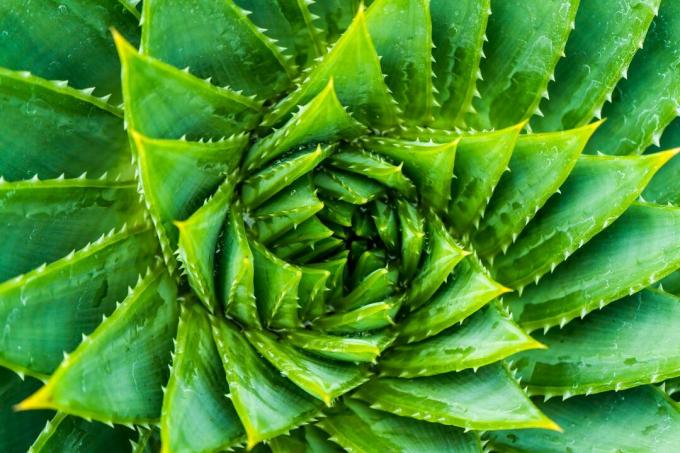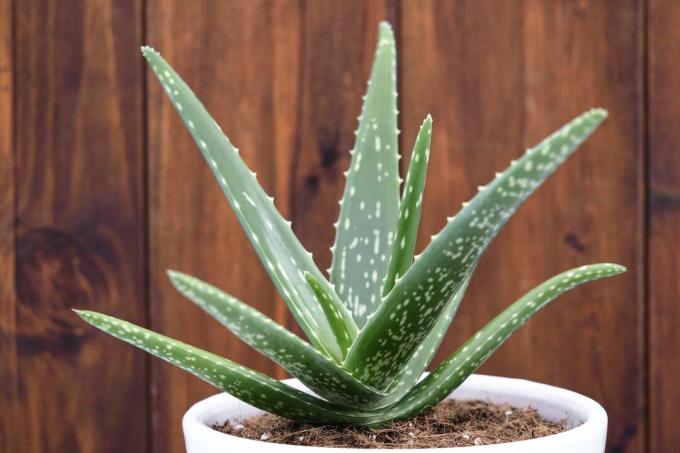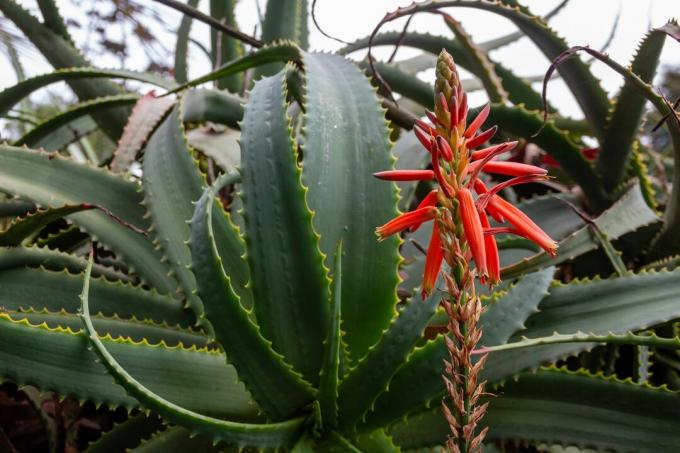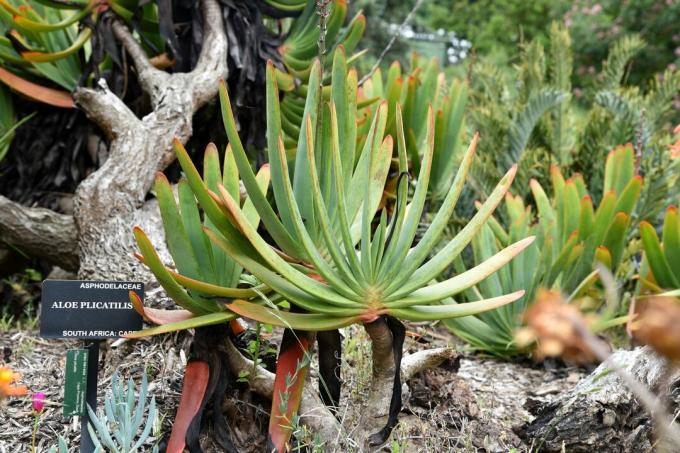Most people especially know those aloe vera as a representative of the aloes. We will show you an overview of other beautiful aloe species.

The genus of aloe consists of far more species than just that aloe vera. We will tell you how many species there are and present you with a brief overview of some of the most beautiful aloe species.
"Contents"
- Aloe Species: How Many Aloes Are There?
-
Aloe species: overview of the most beautiful species
- 1. aloe vera
- 2. Aloe arborescents
- 3. Aloe aristata
- 4. Aloe polyphylla
- 5. Aloe ferox
- 6. Aloe variegate
- 7. Aloe mitriformis
- 8. Aloe plicatilis
- 9. Aloe aculeata
Aloe Species: How Many Aloes Are There?
The aloe genus includes over 500 plant species. But how can you determine the type of aloe? They can usually be easily distinguished by optical characteristics such as leaf color and shape, leaf serrations, growth height or by their flowers. The species can be roughly divided into three groups: the tree aloes, the shrub aloes and the stemless aloes. In principle, all aloe species can be cultivated as houseplants, but the right site conditions, sufficient space and the right care are crucial. The right substrate is also a prerequisite for healthy growth. Since all species are succulents, there are small peculiarities when watering and fertilizing aloes.
Aloe species: overview of the most beautiful species
The variety of aloe species is almost limitless. The spectrum ranges from dwarf forms to high-growing tree aloe species, as well as color variations of the leaves. We present you with a brief overview of the most beautiful types.
1. aloe vera
The best-known representative of the aloe genus is the aloe vera "La vera" means "the real one", which is why it is also called real aloe. From a botanical point of view is also the name Aloe barbadensis right, but could hardly assert itself. The leaves of aloe vera Plant species grow to about 30 to 40 cm long, while the inflorescence can reach a height of 90 cm. It forms showy yellow to orange flowers. Are you interested in the origin, properties or use of the aloe vera? You can find more information on this in our special article on real aloe.

2. Aloe arborescents
the Aloe arborescents is also often referred to as eternal aloe because it can grow very old and up to two meters high. It belongs to the group of tree aloe species and forms several bare false trunks with leaf rosettes at the ends. The leaves are conspicuously serrated on the edge. When flowering occurs, an inflorescence emerges from the heart of the leaf rosette, topped with scarlet flowers. the Aloe arborescents is less common than that aloe vera, but is still one of the most beautiful aloe species. After three years at the latest, side shoots are formed, through which the Aloe arborescents spread. What is special is that the Aloe arborescents is tolerant of brief freezing temperatures. Similar to them aloe vera it is one of the aloe species with healing properties. the Aloe arborescents can relieve itching when applied to the skin. The medical side advises against consuming the ornamental plants, as their harmlessness depends on the correct processing.
The 'Miller' variety, which is characterized by its eye-catching, bright red inflorescence, is particularly widespread.
Tip: Aloes belong to the monocotyledons - the monocotyledonous plants - therefore a stem formation in the classic sense is not possible. Of some species, however, a pseudo-stem is formed from old leaf sheaths.

3. Aloe aristata
the Aloe aristata is also called Spherical Aloe because of its growth. The dwarf form grows completely without a stem and develops leaves up to 15 cm long, which have conspicuous, white toothed edges. In late spring forms the Aloe aristata an orange flower. Older plants form numerous side shoots, so-called Kindel, for propagation. Like some other types of aloe, it is Aloe aristata toxic and has no health-promoting effect. Well-known varieties include 'Cosmo' and 'Magic'.

4. Aloe polyphylla
Because of the spirally arranged leaves, the Aloe polyphylla also called spiral aloe. The short, ovate-elongated leaves taper to a point and are arranged in five rows that spiral in the same direction. The tip of the leaf is often particularly noticeable because of its purple colour. older Aloe polyphylla-Plants form a distinctive rosette, this is not so clearly visible in younger plants. The sap of the Aloe polyphylla is toxic and should not be applied to the skin or consumed.

5. Aloe ferox
the Aloe ferox originally comes from South Africa, which gave it the name Cape Aloe. The species, which belongs to the tree aloes, is also called wild aloe and can form a false trunk up to three meters high. The dull green, sometimes reddish coloured, sprawling leaves are up to 100 cm long. Their wrinkled edges are lined with brown, hard teeth. As well as aloe vera also, has the Aloe ferox a healing effect on skin problems. It is often used for the production of aloe juice because it forms a lot of gel in its thick fleshy leaves. Its flower cluster grows up to 130 cm tall and forms showy, bright red or orange flowers.

6. Aloe variegate
One of the most beautiful dwarf aloes is the Aloe variegate, also known as Tiger Aloe because of its mottled leaves. It grows only 10 to 15 cm high and forms lanceolate, toothless leaves on a small stem. With age, the leaves curl up a bit. The conspicuous, irregular drawing with white transverse bands on the leaves is the distinguishing feature of the Aloe variegate. The red flowers, which are formed by young plants and grow on an inflorescence up to 40 cm long, are particularly beautiful. the Aloe variegate is also one of the poisonous aloe species. For example, a popular variety is Aloe variegate 'Magic'.

tip: Only with sufficient nutrients is it possible for the plant to form healthy and strong leaves. A high-quality green plant fertilizer such as ours is suitable for this Plantura organic indoor and green plant fertilizer. Our organic liquid fertilizer contains microorganisms that promote root formation and nutrient uptake and does not contain any animal ingredients.
7. Aloe mitriformis
Aloe mitriformis Although it is one of the small aloe species, it can form a false stem that is up to two meters long and only grows horizontally. Their 20 cm long leaves have conspicuous serrations on the leaf edge and can be red towards the tip. the Aloe mitriformis forms a small leaf rosette. In good site conditions, it bears small, scarlet flowers. The juice of Aloe mitriformis has a positive effect on skin problems.

8. Aloe plicatilis
One of the largest aloe species is the Aloe plicatilis, whose false trunk can grow up to five meters high and forms a branched crown. Several pseudo-trunks can be formed at the same time. As well as them Aloe ferox she is from South Africa. Because of its sprawling, fan-like growth, it is also called fan aloe. The leaves are very slender in relation to the size of the plant and usually have no teeth on the edge. The inflorescence of Aloe plicatilis grows up to 50 cm high and forms bright red flowers. Because of the substances contained in the milky juice Aloe plicatilis poisonous.

9. Aloe aculeata
the Aloe aculeata is a stemless species of aloe, the leaves of which are arranged in a large leaf rosette. The thick-fleshed leaves, up to 60 cm long, form conspicuous, often red teeth on the leaf edges and spines on the leaf surface. The name "aculeata" comes from Latin and means "prickly". A special feature of Aloe aculeata is the lemon-yellow flower that grows at the end of an inflorescence that is up to 100 cm high. The best-known variety Aloe aculeata is the 'Jurassic Dragon'.

Are you looking for other, native or exotic, evergreen plants for the garden? Then also read our article about popular ones evergreen and hardy shrubs and woody plants.
